|
|||
|
|||
from Tactics & Technique of Infantry, Basic, 1942
Additional Images from Army Life, 1944
Contents:
1. Basic information, definitions, processess
2. Soldier Without Arms
3. Soldier With Arms
4. Drill for Foot Troops - Squad
114. General. a. The squad is a group of soldiers organized primarily as a combat team. It consists of one squad leader and other personnel as authorized by appropriate Tables of Organization. When the squad leader is absent, he is replaced by the second in command. If the second in command is also absent, the next senior member of the squad acts as leader.
b. As far as practicable, the squad is kept intact. The normal formation of the squad is a single rank or single file. This permits variation in the number of men composing the squad.
c. The squad in line marches to the left or to the front only for minor changes of position.
115. Form Squad. a. The command is: FALL IN. At the command Fall in, the squad forms in line as shown in Plate 27. On falling in, each man except the one on the left extends his left arm laterally at shoulder height, palm of the hand down, fingers extended and joined. Each man, except the one on the right, turns his head and eyes to the right and places himself in line so that his right shoulder touches lightly the tips of the fingers of the man on his right. As soon as the proper intervals have been obtained, each man drops his arm smartly to his side and turns his head to the front.
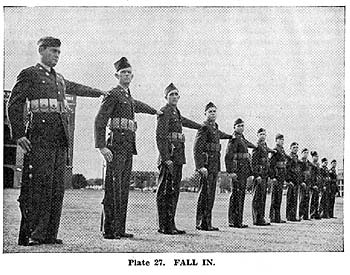
b. To form at close intervals, the commands are: 1. At close interval, 2. FALL IN. At the command Fall in, the men fall in as in a above, except that close interfals are obtained by placing the left hands on the hips as shown in Plate 28. In this position the heel of the palm of the hand rests on the hip, the fingersand thumb are extended and joined, and the elbow is in the plane of the body.
c. The squad falls in on the squad leader. If the squad is formed under arms, pieces are at once inspected.
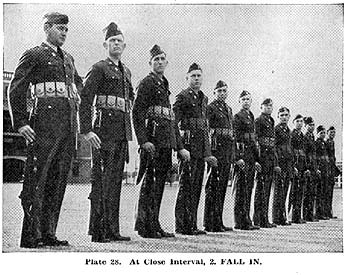
116. Previous Instuctions Applicable. The squad executes the positions, movements, and manual of arms as prescribed in Chapters II and III, all men executing the movements simultaneously.
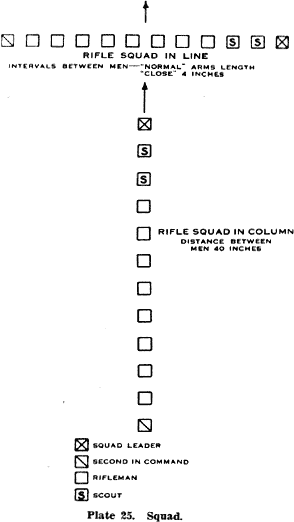

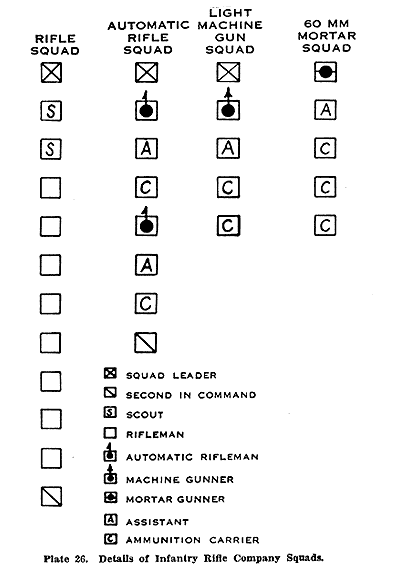
117. Dismiss Squad. The commands are: 1. Inspection, 2. ARMS 3. Port 4 ARMS 5. DISMISSED, or 3- UNLOCK PIECES, 4. DISMISSED (if armed with the Ml rifle).
118. Count Off. a. The command is: COUNT OFF. At the command Count off, each man of the squad, except the one on the right flank, turns his head and eyes to the right. The right flank man calls out, "One." Each man in succession calls out, "Two," "Three," etc., turning his head and eyes to the front as he gives his number.
b. This command may be given whenever it is desired that the men know their relative positions in the squad.
119. Aline Squad. a. If in line, the commands are: 1. Dress right (left), 2. DRESS, 3, Ready, 4. FRONT. At the command Dress, each man except the one on the left extends his left arm (or if at close interval, places his left hand upon his hip), and all aline themselves to the right. The instructor places himself on the right Sank one pace from and in prolongation of the line and facing down the line. From this position he verifies the alinement of the men, ordering individual men to move forward or back as is necessary. Having checked the alinement, he faces to the right in marching and moves three paces forward, halts, faces to the left and commands: 1. Ready, 2. FRONT. At the command Front, arms are dropped quietly and smartly to the side and heads turned to the front.
b. If in column the command is: COVER. At the command Cover, men cover from front to rear with 40 inches distance between men.
120. Being in Line at Normal Interval, Obtain Close Interval. The commands are: 1. Close, MARCH. At the command March, all men except the nght flank man face to the right in marching and form at close interval, as prescribed in paragraph 115 b.
121. Being in line at Close Interval, Extend to Normal Interval. The commands are: 1. Extend 2. MARCH. At the command March all men except the right flank man face to the left in marching and form at normal interval as prescribed in paragraph 115 a.
122. Being in Line, March to Flank. The commands are: 1. Right (left), 2. FACE, 3. Forward, 4. MARCH. The movements are executed as explained in paragraphs 19 and 22 all men stepping off simultaneously.
123.March to Oblique. a. For the instruction of recruits the squad being in column or correctly alined, the instructor causes each man to face half right (left), points out his position, and explains that it is to be maintained in the oblique march.
b. The squad being in any formation, the commands are: 1. Right (left) oblique, 2. MARCH. At the command March, given as the right foot strikes the ground, each individual advances and plants the left foot, faces half right in marching and steps off in a direction of 45° to the right of his original front. He preserves his relative position, keeping his shoulders parallel to those of the guide (man on right front of line or column), and so regulates his step that the ranks remain parallel to their original front.
c. The command Halt is given on the left foot when halting from
the right oblique and on the right foot when halting from left oblique. At the
command Halt, given as the left foot strikes the ground, each individual advances
and plants the right foot, turns to the front on the ball of the right foot,
and places the left foot by the side of the right foot.
d. To resume the original direction; the commands are: 1. Forward,
2. MARCH. At the command March, each individual faces half left
in marching and then moves straight to the front.
e. If at Half step or Mark time while obliquing, the Full
step is resumed by the command: 1. Oblique. 2. MARCH.
f. To give volume to the command the word "oblique" is pronounced
to rhyme with "strike."
124. March Toward Flank While in March. a. The commands are: 1. By the right (left) flank, 2. MARCH. At the command March, each individual executes the movement as prescribed in paragraph 30.
b. This movement is used when a quick movement to the right or left for a short distance is required. Normally the unit is halted, faced in the desired direction, and started forward again by the commands: 1. Forward, 1. MARCH.
125. Being in Column, Change Direction. The commands are: 1. Column right (left) (half right) (half left,) 2. MARCH. At the command March, the leading man executes the movement as prescribed in paragraph 29 a or b. The other men in the column execute the same movement successively and on the same ground as the leading man.
126. Being in Line, Take Interval and Assemble. a. To take interval, the commands are: 1. Take interval to the left (right), 2 MARCH. At the command March, the right flank man stands fast and extends his left arm at shoulder height, palm of the hand down, fingers extended and joined until the man on his left obtains the proper interval, then he drops his arm. Other men face to the left in marching and step out until they have an interval of two arms' length from the man on their right. Each man, except the one on the left who raises his right arm only, extends both arms laterally at shoulder height. Each man, except the right flank man, then turns his head and eves to the right and places himself in line so that the finger tips of his right hand touch lightly the finger tips of the left hand of the man on his right. As soon as each man alines himself at two arms' length intervals from the man on his right, he drops his right arm to the side and turns his head and eyes to the front. He drops his left arm to the side when the man on his left has obtained his proper interval. If under arms. rifles will be slung prior to the execution of this movement.
b. To assemble, the commands are: 1. Assemble to the right (left), 2. MARCH. At the command March, the right flank man stands fast. All other men face to the right in marching and form at normal intervals as in paragraph 115 a,
127. Stack Arms. a. The rifle squad being in line at normal or close interval, the commands are: 1. Stack, 2. ARMS. Numbers 2, 5, 8, and 11 make the stacks except when no men are on the left of these numbers. The stack is made as follows: At the command Arms, the man on the left of the stackman regrasps his rifle with his right hand at the balance, carrying it to the horizontal position, barrel up, and passes his rifle to the stackman who grasps it with his left hand between the upper sling swivel and stacking swivel and places the butt between his feet, barrel to the front, muzzle inclined slightly to the front, the thumb and forefinger raising the stacking swivel. The stackman then throws the butt of his own rifle 2 feet in advance of that of his left file and 6 inches to the right of his right toe; at the same time he allows his right hand to slip to the stacking swivel and engages his rifle with that of his left file- The man on the right of the stackman raises his rifle with his right hand, regrasps it with his right hand at the balance, steps to the left front keeping his right foot in place, and carries his rifle well forward, barrel to the front; the left hand guiding the stacking swivel engages the lower hook of the swivel of his own rifle with the free hook of that of his left file, and then turns the barrel outward into the angle formed by the other two rifles and lowers the butt to' the ground so that it will form a uniform stack with the other two rifles. He then assumes the position of attention. Other rifles of the squad are passed toward the nearest stack and laid on the stack by the stackman.

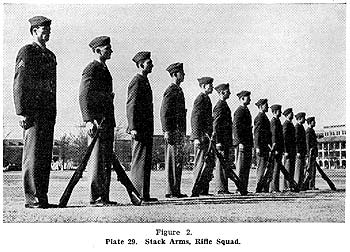
b. The automatic rifle squad, rifle company, being in line at normal or close interval, the commands are: 1. Stack, 2. ARMS. The second man from the left makes the stack, The stack is made as follows: At the command Arms, the man on the left of the stackman regrasps his rifle with the right hand at the balance, carrying it to the horizontal position, barrel up, and passes his rifle to the stackman who grasps it with his left hand between the upper sling swivel and stacking swivel and places die butt between his feet, barrel to the front, muzzle inclined slightly to the front, the thumb and forefinger raising the stacking swivel. The stackman then throws the butt of his own rifle 2 feet in advance of that of his left file and 6 inches to the right of his right toe; at the same time he allows his right hand to slip to the stacking swivel and engages his rifle with that of his left file. The nearest rifle on the right is then passed to the man on the right of the stackman who raises the rifle with his right hand at the balance, steps to the left front keeping his right foot in place, and carries the rifle well forward, barrel to the front; the left hand guiding the stacking swivel engages the lower hook of the swivel of the rifle with the free hook of that of the stackman, and then turns the barrel outward into the angle formed by the other two rifles and lowers the butt to the ground so that it will form a uniform stack with the other two rifles. He then assumes the position of attention. Automatic rifles and the other rifles of the squad are passed toward the stack and laid on the stack by the stackman.
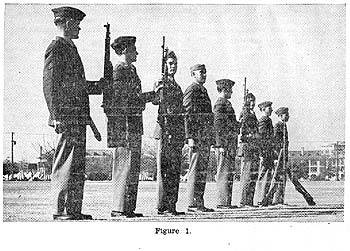

c. The rifle squad of the antitank company and other types of squads in general stack arms with the methods prescribed in a and b above.
128. Take Arms. The squad being in line behind the stacks, the commands are: 1. Take, 2. ARMS. At the command Arms, the procedure of stacking arms is reversed. The loose rifles are first passed back. In breaking the stack, the stackman grasps his rifle and that of the man on his left, so that the rifles will not fall when the man on the right raises and disengages his rifle. Each man, as he receives his rifle, resumes the position of Order arms.
129. Column of Twos. When marching small groups not at drill, the group may be marched in column of twos by forming it in two ranks and giving the command 1. Right (left), 2. FACE.
130. Form Column of Twos From Single File and Reform. a. The squad being in column at a halt, to form column of twos the commands are: 1. Form column of twos, 1. MARCH. At the command March, the leading man stands fast; the second man in the squad moves by the oblique until he is to the left of and abreast of the corporal with normal interval, and halts; the third man moves forward until behind the corporal with normal distance and halts; the fourth man moves by the oblique until he is to the left of and abreast of the third man with normal interval, and halts; and so on.
b. The squad being in column of twos, in marching to re-form single
file, the squad is first halted. The commands are: 1. Form single file from
the right, 2. MARCH. At the command March, the leading man
of the right column moves forward, the leading man of the left column steps
off to the right oblique, then executes, Left oblique so as to follow
the right file at normal distance. Remaining twos follow successively in like
manner.